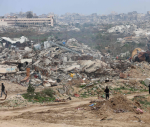You are here
Israel’s strategic plan in Lebanon: A path to regional isolation
Oct 06,2024 - Last updated at Oct 06,2024
From Hizbollah Secretary-General Hassan Nasrallah’s assassination, Israel began implementing a systematic plan consisting of three key parts. First, Israel aimed to depopulate southern Lebanon by forcing residents to flee. Second, it launched major strikes on Beirut’s southern suburb, intending to clear it of civilians as well. Meanwhile, Israel has also worked to gradually isolate Lebanon by tightening its control over Lebanon’s air, sea, and land borders. Israeli warships were positioned off Beirut’s coast, and Israeli authorities imposed monitoring and control over Beirut’s airport, barring Iranian aircraft from landing. The Masnaa border crossing with Syria was also targeted, under the pretext that it serves as a logistical lifeline for Hizbollah.
All these steps have contributed to Israel’s larger goal of severing the connection between Beirut and Tehran. Hizbollah is now confronting a dangerous reality, as Lebanon’s internal geography is being fractured. The group faces the isolation of southern Lebanon from Beirut’s southern suburbs and vice versa, resulting in an unprecedented crisis on humanitarian, security and military levels.
Israel’s current focus on Lebanon, targeting Hizbollah strongholds in both the south and Beirut’s southern suburb, also aims to reshape Lebanon’s internal geography and demographics. As the humanitarian crisis deepens, Israel seeks to deprive Hizbollah of its popular support base, much like the ongoing situation in Gaza. Israel’s security doctrine rejects the future prospect of dealing with complex geographical zones that serve as operational bases and provide popular backing for Hizbollah.
Israel’s shift of focus from Gaza to Lebanon, after significantly containing the situation in the West Bank, suggests that operations in Lebanon will continue at a rapid pace. However, a ground invasion remains a significant challenge that Israel may struggle to resolve easily. As a result, Israel is likely to intensify pressure on Hizbollah’s strongholds through continued airstrikes and bombardments in the south, focusing on cutting off supply chains and preventing logistical support from abroad.
At the same time, Israel considers the Syrian front to be one of the ongoing battlegrounds in this conflict. With the escalation of hostilities in Lebanon, Israeli operations in Syria are likely to increase, especially against Iraqi factions allied with Iran.
Regionally, the prospect of an all-out war has resurfaced with the renewal of Iranian attacks on Israel. The expected Israeli response may break the traditional rules of proportionality that Iran has adhered to in its most recent attacks. However, it is essential to reassess the concept of “total war” and its scope. After a full year of continuous regional conflict, the idea of a “total war” can be understood as the direct confrontation between Iran and Israel. Yet, the dismantling of the surrounding fronts — Gaza, the West Bank, the Golan Heights, and Lebanon — reveals that the ultimate decision to escalate this confrontation lies with Israel, not Iran.
Following the 2004 Iraq invasion, there were growing calls for military action against Iran. However, Israel’s failed 2006 war against Hizbollah and the unsuccessful 2008 war against Hamas delayed any such plans. Today, Israel’s method of neutralising Gaza and Hamas, alongside its campaign against Hizbollah in Lebanon, has greatly restricted Iran’s options for shifting the crisis to Israel’s internal front and making war more costly for the Israelis.
Since the assassination of Iranian president Ebrahim Raisi, questions have emerged about internal shifts in Iran. The Iranian political landscape appears divided. One faction seeks to repair relations with the West and avoid a devastating blow to Iran, while another, represented by the Iranian Revolutionary Guard, insists that its regional policies are what give Iran negotiating power. Israel’s current strategy is to weaken the Revolutionary Guard’s influence in the region, disabling its operational arms and eliminating its capacity to threaten Israeli security.
Targeting the Revolutionary Guard is akin to Israel’s claim that its battle in Gaza is against Hamas, its battle in Lebanon is against Hizbollah, its battle in Yemen is against the Houthis, and in Iraq, against the Popular Mobilisation Forces. Within Iran, Israel’s next target is clearly the Revolutionary Guard, as even the US ambassador to the United Nations recently highlighted, singling out the Guard rather than Iran as a whole. This increases the likelihood of Israeli strikes on key Revolutionary Guard sites, arms factories, and vital facilities that serve the Guard’s interests in any forthcoming conflict.
In summary, Israel’s strategy of dividing and isolating its opponents on multiple fronts enhances its ability and boldness to directly strike Iran with greater force and precision.














Add new comment